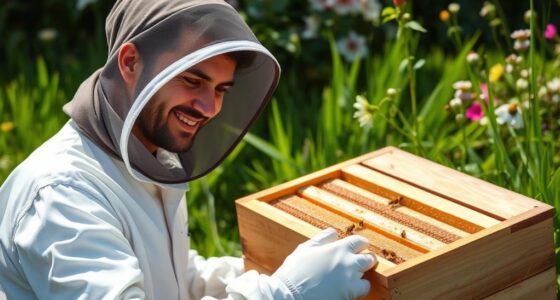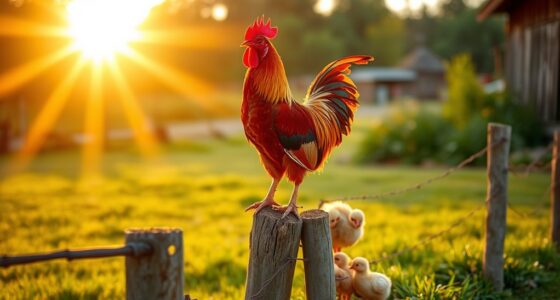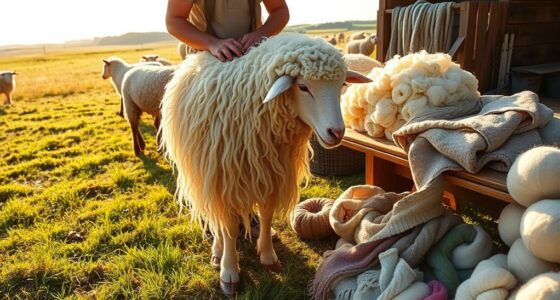To effectively control flies on pastured cattle in July, monitor fly populations to identify hotspots and remove manure daily. Use well-timed insecticide applications, ensuring even coverage and proper safety steps. Incorporate biological controls like parasitic wasps and design traps with appropriate baits away from resting areas. Improve cattle comfort with shade and hygiene, and combine these tactics in an integrated approach. For detailed strategies on keeping flies at bay, continue exploring proven methods.
Key Takeaways
- Regularly monitor fly populations and target breeding hotspots with manure removal and pasture rotation.
- Apply insecticides during peak fly activity with proper coverage, timing, and protective equipment.
- Use strategic fly traps away from cattle resting areas, replenishing bait regularly for effective control.
- Provide shade, clean water, and maintain pasture hygiene to reduce fly attraction and breeding sites.
- Combine biological controls, pasture management, and chemical methods for integrated, sustainable fly management.
Monitoring Fly Populations and Identifying Hotspots
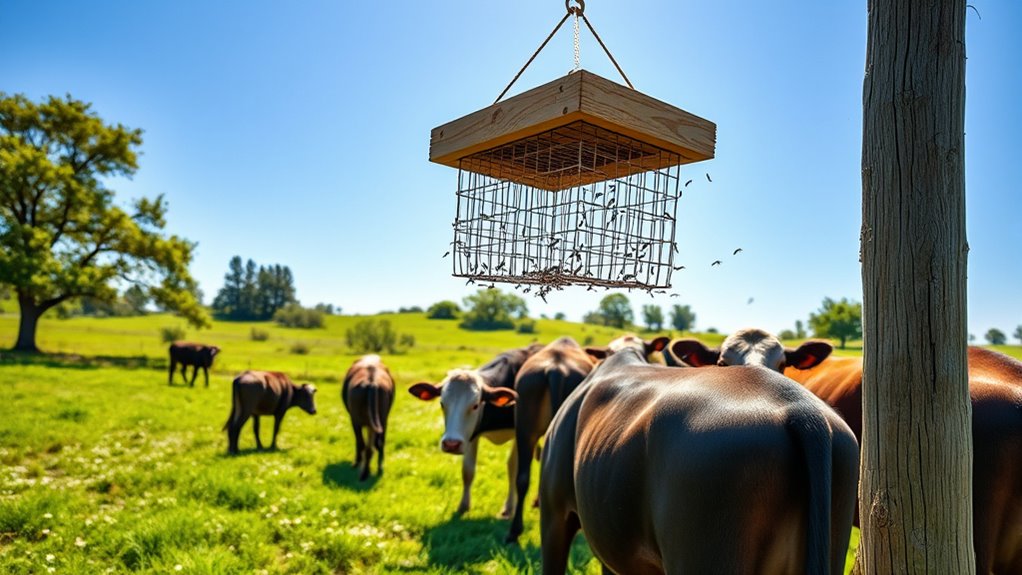
Monitoring fly populations is essential for effective fly control on pastured cattle farms. By regularly observing fly activity, you can identify hotspots where populations thrive, allowing targeted interventions. Tracking fly numbers helps determine if your current strategies are working or if adjustments are needed. Incorporating fly resistant breeds through genetic selection can reduce fly burdens naturally, decreasing reliance on chemical controls. These breeds are less attractive to flies or better at tolerating infestations, making monitoring even more vital to assess their effectiveness. Stay vigilant by inspecting cattle and pastures frequently, especially in shaded or damp areas where flies tend to gather. Understanding fly behavior can be improved by environmental conditions and implementing integrated pest management practices. Recognizing fly behavior patterns helps in timing control measures more effectively. Consistent monitoring and understanding fly behavior enable you to implement timely, precise control measures, ultimately improving cattle health and farm productivity.
Implementing Proper Pasture Management Techniques
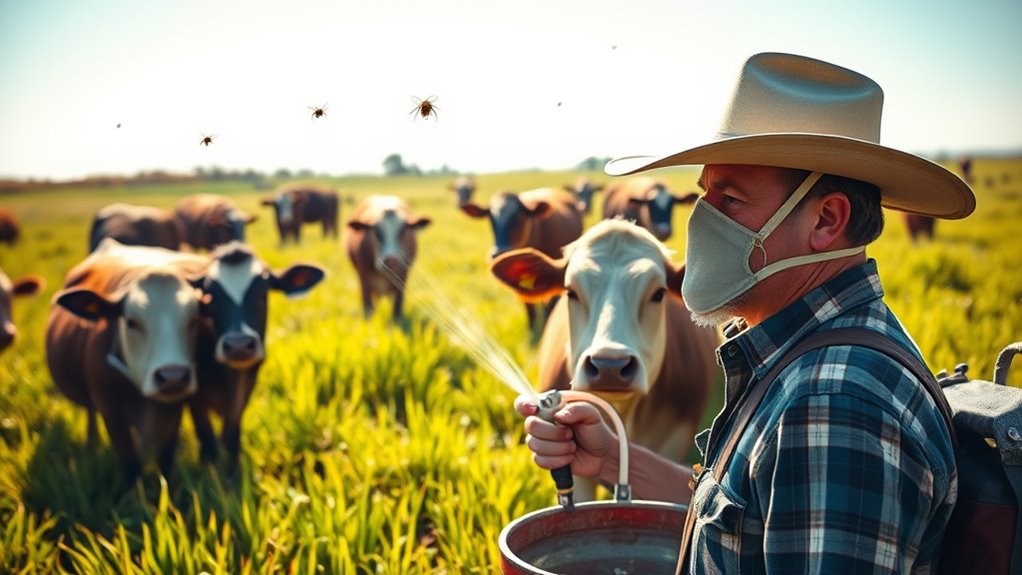
Effective pasture management can markedly reduce fly populations by creating less favorable environments for breeding and resting. Understanding seasonal fly patterns helps you time management practices effectively, targeting peak periods when flies are most active. By rotating pastures, you interrupt the fly life cycle, preventing larvae from developing in manure or wet areas where they thrive. Avoid overgrazing, which can create muddy, damp conditions ideal for flies. Properly managing manure—disposing of or composting it promptly—reduces breeding sites. Maintaining well-drained, dry pastures limits fly resting spots. Incorporating nutrient-dense forage options can improve cattle health and resilience against pests. Additionally, implementing sustainable pasture practices supports long-term pasture health and pest control. These techniques disrupt the seasonal patterns and shorten the fly life cycle, decreasing overall populations. Proper sanitation and manure management further enhance these efforts by reducing breeding grounds effectively. Regular monitoring and adjusting management strategies based on fly activity can further optimize pest control efforts.
Applying Insecticides Safely and Effectively
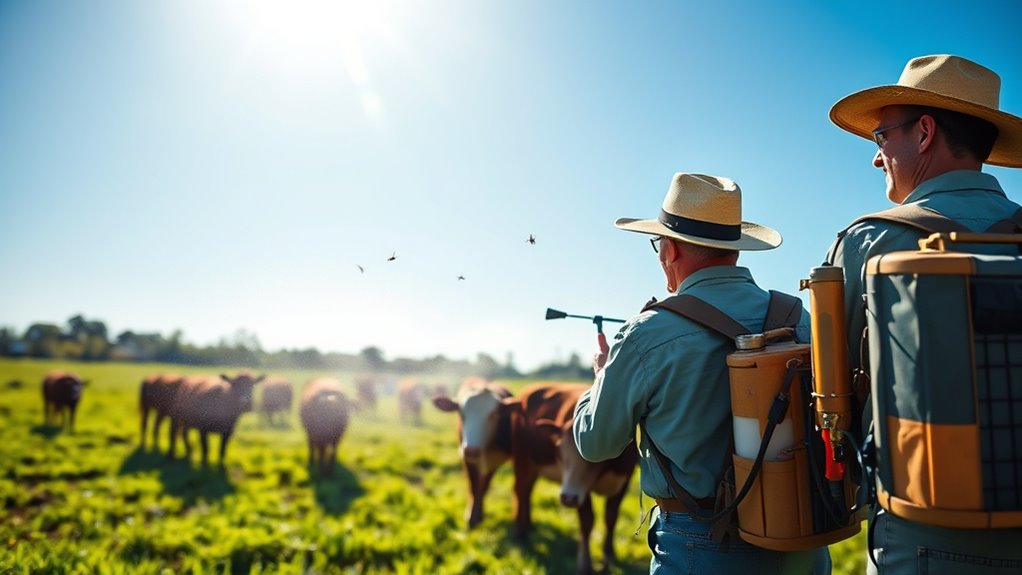
To get the best results, you need to apply insecticides correctly and safely. Make sure you follow proper application techniques to avoid waste and protect yourself from exposure. Always wear the recommended PPE and observe safety precautions to keep yourself and your cattle safe. Incorporating effective filtration technology and staying informed about the latest advancements can further enhance the effectiveness of your fly control strategies. Additionally, understanding environmental considerations can help you minimize your impact on the surrounding ecosystem while managing pests effectively. Regularly inspecting your equipment and knowing appliance safety standards can also prevent accidents and ensure the proper functioning of your application tools. Being aware of application technique best practices ensures efficient and safe insecticide use.
Proper Application Techniques
Applying insecticides safely and effectively is essential to control flies without harming your cattle or the environment. Proper application techniques guarantee the fly spray functions at its best. Here are key steps to follow:
- Choose the right fly spray based on your cattle’s needs and environmental conditions.
- Apply during the right application timing, typically early in the day or late evening when flies are most active.
- Use consistent, even coverage by spraying from shoulder to tail, avoiding excessive application.
- Avoid applying before rain or when winds are strong to prevent runoff and drift.
- Ensuring proper trust issues with your application process can help prevent missteps and ensure effective fly control.
Safety Precautions and PPE
Ensuring your safety and that of your cattle requires careful attention to safety precautions and the proper use of personal protective equipment (PPE). Always wear protective clothing, such as gloves, long sleeves, and eye protection, to minimize exposure to insecticides. Before handling any chemicals, read the label thoroughly and follow all instructions for safe handling. Keep insecticides in their original containers and store them securely away from children and animals. When applying, avoid eating, drinking, or smoking to prevent accidental ingestion. Proper PPE and safe handling reduce health risks and ensure effective fly control. Additionally, understanding the contrast ratio of your equipment can help optimize the effectiveness of visual cues during application. Regularly inspecting your water-resistant PPE ensures it remains effective in various conditions. Remember, prioritizing safety not only protects you but also guarantees the insecticides work as intended without unnecessary hazards. Incorporating proper storage practices can further prevent accidental exposure and contamination.
Utilizing Biological Control Methods
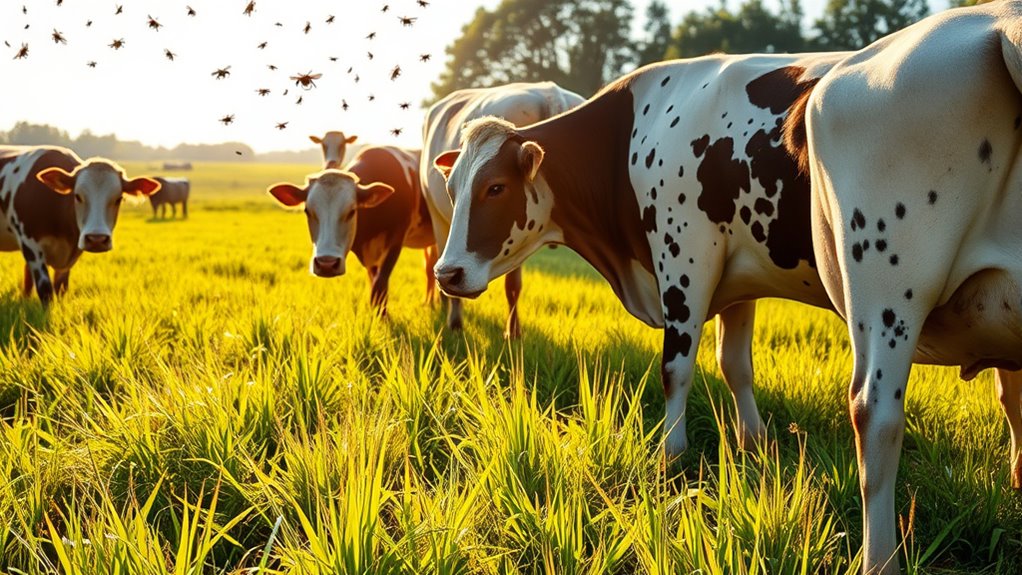
Biological control methods offer a sustainable way to manage fly populations on pastured cattle by harnessing natural enemies. You can leverage genetic selection to breed cattle that attract fewer flies or support populations of natural predators that target fly larvae. Introducing or encouraging these predators helps keep fly numbers in check without chemical use. Here are some key strategies:
- Use genetic selection to breed cattle less attractive to flies.
- Promote natural predators like parasitic wasps that attack fly pupae.
- Enhance pasture conditions to support predator populations and ecosystem health.
- Avoid practices that disturb beneficial insects and natural enemies.
- Incorporate resilience principles into pasture management to sustain predator habitats and improve overall ecosystem health. Maintaining diverse plant species in pastures can attract and sustain beneficial insects, contributing to the biological control process. Additionally, understanding the role of integrated pest management techniques can further optimize fly control efforts while supporting ecological balance.
Using Fly Traps and Baits for Targeted Reduction
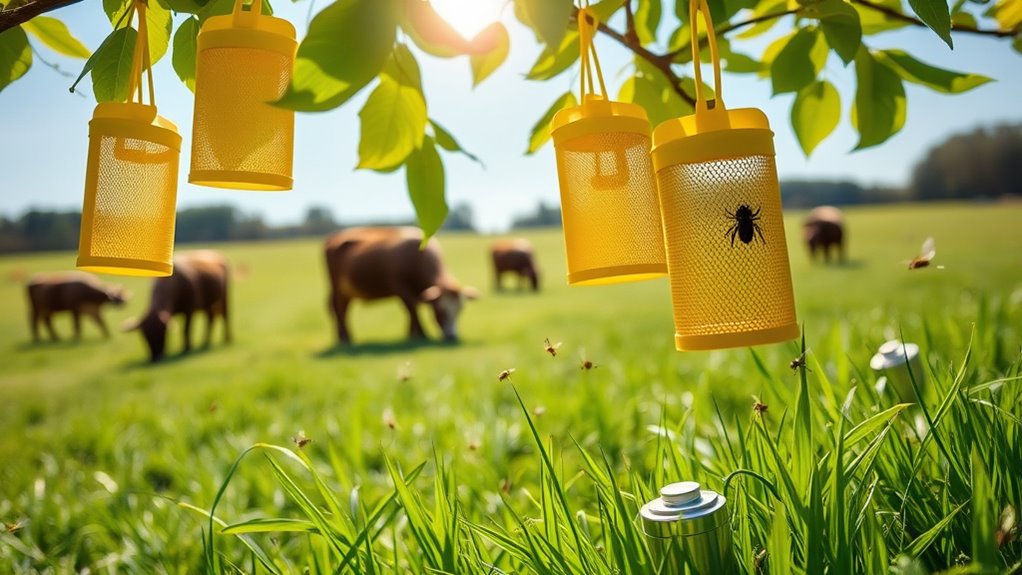
Fly traps and baits are effective tools for targeting and reducing fly populations around pastured cattle. Proper trap placement is key; position traps away from cattle resting areas to avoid drawing flies toward animals. Use bait formulation that attracts the specific fly species in your area—sweet scents or protein-based baits often work well. Regularly check traps and replace baits as needed to maintain effectiveness. Consider the following table for ideal trap placement and bait choices:
| Trap Placement | Bait Formulation |
|---|---|
| Near manure piles | Protein-based attractants |
| Along fly corridors | Sweet-scented baits |
| Shaded, sheltered spots | Rotating bait types |
Enhancing Cattle Comfort and Hygiene Practices
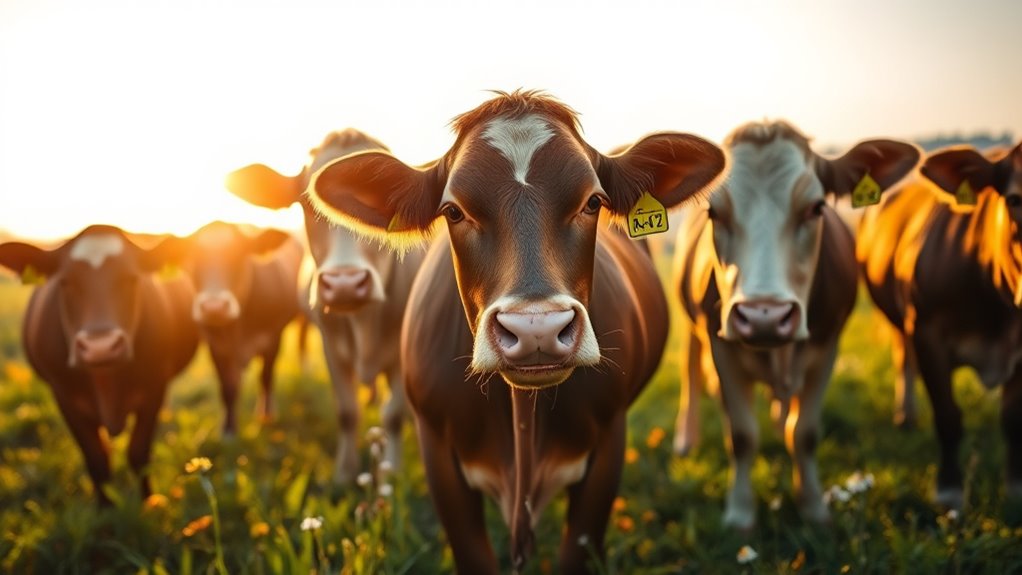
Keeping your pasture clean, providing shade, and ensuring cattle have plenty of water can make a big difference in fly control. Regular hygiene reduces breeding sites and keeps your animals comfortable. Using fly-repellent strategies alongside these practices offers added protection for your cattle. Incorporating ethical hacking that reflect the animals’ personality traits can also improve herd management and comfort.
Regularly Clean Pasture Areas
Regularly cleaning pasture areas is essential for maintaining cattle comfort and reducing fly populations. By removing fly eggs and debris, you prevent larvae from developing. Implementing a pasture rotation schedule disrupts fly breeding cycles and keeps grazing areas fresh. Here are key practices to contemplate:
- Remove manure daily to eliminate fly eggs and larvae.
- Rotate pastures to prevent buildup of manure and organic matter.
- Mow overgrown areas to reduce breeding sites.
- Avoid overstocking to minimize manure accumulation.
- Incorporate sustainable pasture management practices to maintain long-term health of the grazing environment.
These steps help break the fly life cycle and improve overall hygiene. Ensuring pasture cleanliness not only lowers fly populations but also enhances cattle comfort, health, and productivity. Regular maintenance creates a less hospitable environment for flies and supports sustainable pasture management.
Provide Adequate Shade and Water
Providing adequate shade and water is essential for maintaining cattle comfort and reducing fly problems. Proper shade provision helps cattle stay cool, minimizing stress and the need for excessive sweating, which can attract flies. Ensuring access to clean, fresh water through effective water management keeps cattle hydrated and discourages them from congregating around dirty, fly-breeding areas. Adequate shade also helps distribute cattle more evenly across pastures, reducing overgrazed spots and manure buildup that attract flies. Regularly inspect shade structures for damage and refill water sources to maintain consistent availability. By prioritizing shade provision and water management, you create a healthier environment, lessen fly breeding sites, and promote overall cattle well-being.
Use Fly-Repellent Strategies
Implementing fly-repellent strategies is a crucial step in enhancing cattle comfort and maintaining hygiene. Using natural repellents can be effective, especially when applied during peak fly activity. Timing is key—apply repellents at the right seasonal timing to maximize their impact. Consider these strategies:
- Use natural repellents like neem oil or citronella-based sprays during early summer and late fall.
- Incorporate fly tags or ear tags with repellent properties for ongoing protection.
- Apply fly sprays containing pyrethroids or natural ingredients as needed.
- Maintain pasture hygiene and remove manure regularly to reduce breeding sites.
Combining these tactics helps minimize fly populations, keeps cattle comfortable, and reduces disease risk. Proper timing and natural repellents are essential for an effective, sustainable fly control plan.
Frequently Asked Questions
What Are the Signs of Fly Infestation on Cattle?
You’ll notice signs of fly infestation on your cattle through excessive fly behavior, like constant head shaking, tail swatting, and ear flicking. Watch for cattle scratching or rubbing against objects, which indicates discomfort. Fly breeding sites, such as manure and mud, attract these pests, increasing their presence. If you observe these behaviors and breeding grounds, it’s a sign you need to take action to manage the fly problem effectively.
How Often Should Fly Control Measures Be Applied?
Timing is everything when it comes to fly control on your cattle. You should apply treatments every 2 to 4 weeks during peak fly season to stay ahead of the game. This helps with timing optimization and extends product longevity, so your efforts aren’t wasted. Keep a close eye on the weather and fly activity, and adjust your schedule as needed to maintain a fly-free environment for your cattle.
Are There Natural Repellents Effective for Fly Prevention?
You’re wondering if natural repellents work for fly prevention. Plant-based repellents, like citronella or eucalyptus oils, can help deter flies when applied properly. Mineral oil sprays are also effective, creating a barrier that keeps flies away. While these natural options may not be as long-lasting as chemical treatments, they’re safe for your cattle and environment. Regular application enhances their effectiveness, making them a good addition to your fly control strategy.
Can Fly Control Methods Impact Cattle Health?
You might wonder if fly control methods impact cattle health. Using biological treatments can be safe and environmentally friendly, helping reduce fly populations without harming your cattle. However, chemical sprays, if misused or overapplied, could cause health issues or stress to your animals. It’s essential to follow label instructions carefully and combine methods for effective, safe fly management that protects your cattle’s well-being.
What Are the Costs Associated With Different Fly Control Strategies?
You might find that the costs of fly control strategies vary widely, but an economic analysis reveals that preventive measures often save money in the long run. While insecticide treatments can be affordable upfront, they may require repeated applications. On the other hand, integrated approaches like pasture rotation and biological controls have higher initial costs but reduce ongoing expenses. Balancing these options helps you choose a cost-effective plan that keeps your cattle healthy and productive.
Conclusion
By combining these fly control tactics, you’re creating a fortress against pests that threaten your cattle’s health and comfort. Think of it as tending a garden—you must regularly prune, water, and shield your plants to keep weeds at bay. With consistent monitoring, proper management, and targeted solutions, you’ll keep your pastures thriving and your cattle happy, ensuring a smooth, pest-free season ahead. Stay vigilant, and your efforts will pay off like a well-tended field in full bloom.




